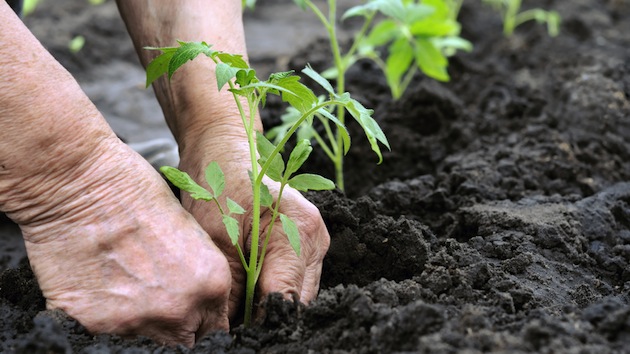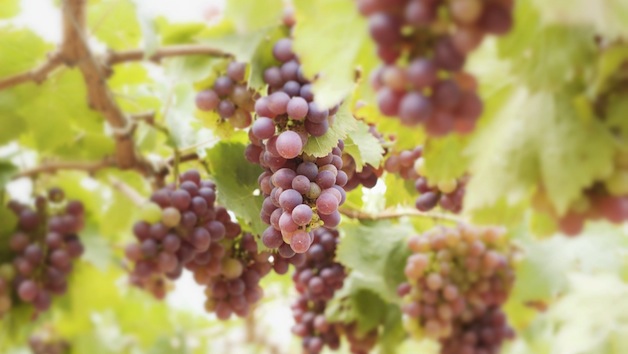The Suburban surged and swerved, rattling across potholes and rocketing over heaves in the sun-scorched asphalt. At the wheel, Adolfo Murillo smiled with pride. “This road we’re on here,” he said, “for years and years and years was never paved.” Going back to the 1940s, local politicians had run on promises of laying down tarmac but never made good. The highway was only leveled and tarred about a decade ago, in part to accommodate the truckloads of agaves traveling the 16 miles from Murillo’s fields near the dusty village of Agua Negra to the tequila distilleries in Arandas, Jalisco, in central Mexico. Murillo steered with one hand and twisted the cork of a bottle of tequila with the other. The rubber stopper squeaked then popped, like a wet kiss, and the cab instantly filled with the smell of baked agave.
In just eight years on the market, Murillo’s brand, Alquimia, has won 35 gold medals in international contests, including best in show for its extra añejo—the classification for tequila aged in an oak barrel for more than three years—at the San Francisco World Spirits Competition in March. The key, Murillo told me, is in the high sugar content of his plants. Many larger distillers have embraced the extra añejo category, because strong oaky flavors can mask poor-quality tequila, but the natural flavor of the plant is overwhelmed. “If you age tequila too aggressively,” Murillo told me, “you lose the agave characteristics.” To demonstrate the contrast, he poured his añejo into plastic tasting cups perched on the armrest between our seats, somehow topping off each shot as he braked and eased around craters in the blacktop.
Watching the red-clay hills slip by, I sipped the shot, relaxing a bit into my seat, the rich vegetal sweetness of agave mixing with the smokiness of toasted oak.
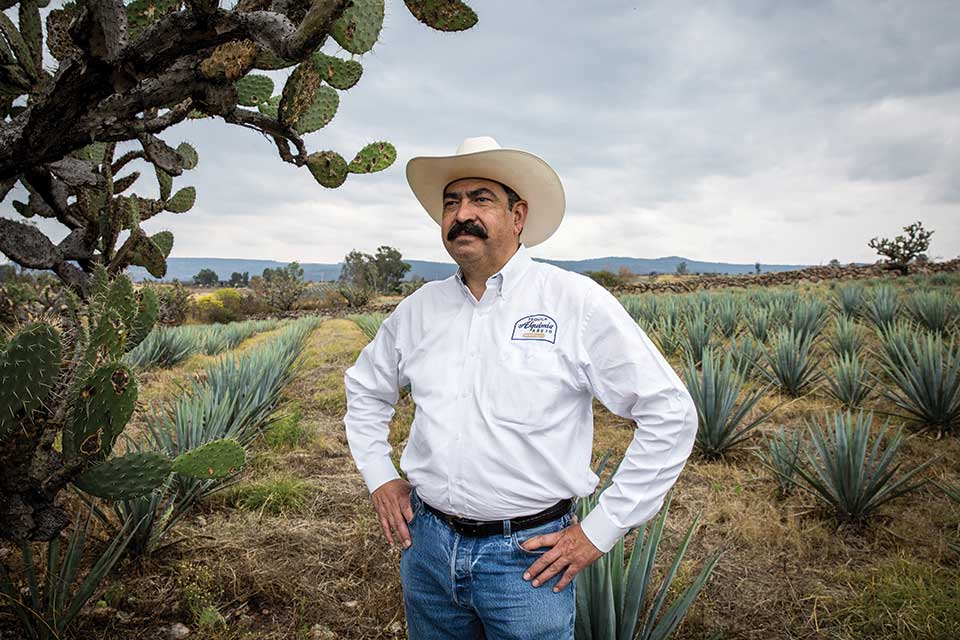
The 58-year-old Murillo was born in Agua Negra, where his grandfather was a small-plot farmer, but in 1961 his parents moved their family to Ojai, California, where his father, who later became a US citizen, oversaw a poultry operation. Adolfo returned to his grandparents’ farm every few summers, until he went to UC-Santa Barbara to get a bachelor’s degree in biological sciences. He got his doctorate in optometry at UC-Berkeley, and on weekends, he and his wife would drive up to the Napa Valley and fantasize about owning a winery. But when his grandmother died, Murillo began to dream of blue agaves instead.
Locals thought he was nuts. Agua Negra is within the official zone for tequila production, but no one had ever tried cultivating agave in this high-desert region. Everyone told Murillo it was too cold, there was too little rain, and the soil wasn’t red enough—not enough iron to sustain agave. But Murillo turned to science: He had the soil tested and found that it had a very similar chemical composition to the highly productive fields of Arandas, to the southwest. And because it had been generations since the area around Agua Negra had been used to raise large-scale cash crops, the soil could be quickly restored to its organic state.
“Agriculture in Mexico is very chemical intensive,” Murillo said as we arrived at the gate of his ranch. In the early 1970s, when the United States flooded the world market with cheap corn, many Mexican farmers turned to herbicides, fungicides, and insecticides as a way of improving crop yields and staying competitive. But those industrial methods had largely bypassed the small farms of Agua Negra, and Murillo believed that, with a little help from chicken manure and micronutrients, the local dirt could produce a superior agave. Murillo was right. He boasts that his first harvest, in 2000, produced agave hearts with nearly twice the sugar content of other agaves raised around Arandas. Because alcohol is produced by fermenting raw sugars, Murillo’s sugar-rich agaves were highly sought-after—especially since many other growers had lost crops to disease and bad weather that year. He found ready buyers among large distillers, like Cazadores and Herradura, but the big tequila companies saw the opportunity. They began leasing land around Agua Negra themselves, planting their own agaves and spraying with fertilizers and pesticides, rather than hiring local workers to tend the fields by hand.
Murillo was determined to show that his organic methods yielded a better product. He started Alquimia (a nod to Paulo Coelho’s novel The Alchemist, whose protagonist pursues an impossible dream) while still maintaining his optometry business in Oxnard. Now, he jokes, “I help people see twice as well during the week, and then I help them see double on the weekend.”
Murillo let the Suburban roll to a stop at the crest of the ridge. Row upon row of blue agaves stretched in all directions, each plant’s needle-tipped leaves rising head high. It was the realization of Murillo’s dream—but he had bigger ambitions. “I can only do so much on my grandfather’s rancho,” Murillo said, “but if I can recruit my neighbors and they recruit others, then we will have a movement.”
Agave-derived alcoholic beverages have been a staple in rural Mexico since pre-Hispanic times, but the plant is notoriously difficult to cultivate at scale. It’s vulnerable to weevils, fungi, bacteria, and cold snaps. And unlike the grains used to produce whiskey and vodka, the blue agave typically takes 6 to 10 years to reach maturity, so a single crop loss can set a grower back a decade. When demand for tequila first began to surge worldwide in the late 1960s, Mexico loosened production standards to allow tequila makers to use nonagave sugars—in the process creating the cheap, hangover-inducing classification known as mixto that gave tequila a bad name. Still—thanks to Jimmy Buffett, the rise of chain Mexican restaurants and the frozen margarita, and generations of wayward frat boys—demand continued to climb, making brands like Jose Cuervo and Sauza into international powerhouses.
But then in 1989, Patrón changed the game, proving that Americans would pay a higher price for prestige bottles of tequila. Since then, imports of pure agave tequila have doubled—with the greatest leap coming in the super-premium division, where sales of high-end tequilas have increased five times over. The billion-dollar market has become so lucrative that George Clooney, Sean Combs, and Justin Timberlake all have their own brands. And now that the Mexican government has negotiated an end to Beijing’s ban on the liquor, it projects 2.6 million gallons—more than $100 million—in sales to China by 2020.
All that growth has pushed growers to plant vast monoculture fields and deploy the products of American agrichemical companies. (It’s not unusual to see fields proudly emblazoned with indicators for Monsanto or Pioneer.) But there are signs of change among the big players as well. In 2012, Sauza announced that they would shift their entire top-shelf line, Tres Generaciones, over to organically certified blue agave. I went to their research lab just outside the town of Tequila to meet the company’s technical director, José Ignacio del Real Laborde.
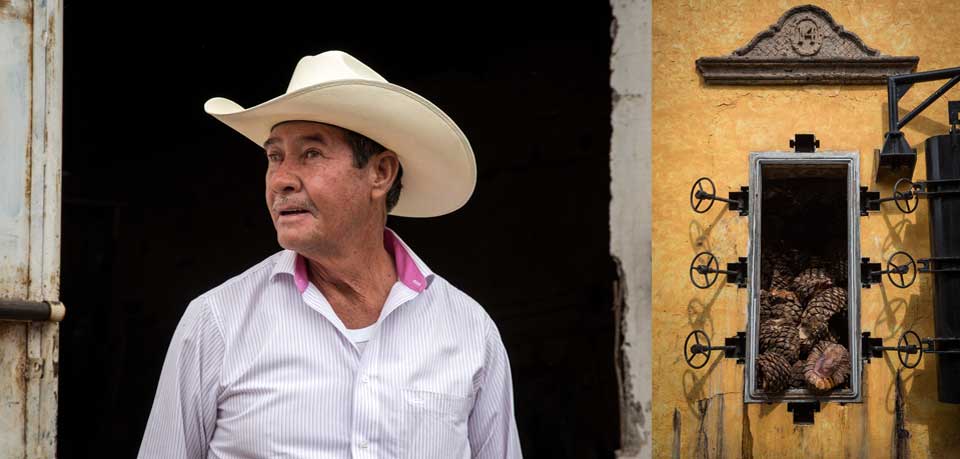
Del Real was candid. He said that when Fortune Brands, the owner of Jim Beam and Knob Creek, acquired Sauza in 2005, it almost immediately took a close look at the early success of small organic brands like Alquimia. Fortune concluded that such products represented a growth market, especially in China, where—because of mounting fears about environmental contamination—organic products are prized. Del Real confessed he didn’t quite understand why anyone would pay a premium for an organic bottle. Tequila, after all, is a distilled spirit, so all contaminants are pretty well eliminated. And how would something as small as what tequila you drink have much environmental impact? “It’s about paying for your sins,” he told me, cracking a wry grin. “So someone can drive a big car but still make themselves a friend of the environment by buying organic tequila?”
Still, del Real went along with the plan. Together with Lois Christie, an organic certification consultant, they scouted fields in the far southern reaches of tequila’s required denomination of origin. Agaves had never been grown there before, so it was easier to find clean soil. Del Real, who has a Ph.D. in plant science from Utah State University, developed pesticide-free management techniques, such as pheromone-baited traps for the agave weevil and the use of beneficial insects to reduce fungal infections.
Sauza has since been bought by Japanese liquor giant Suntory, but Christie assures me that it remains committed to maintaining Tres Generaciones as an organic line. And she said she was encouraged to see other distillers beginning to adopt aspects of organic production. In fact, on a recent visit to the palatial Patrón facility in Atotonilco El Alto, I toured a massive plant for composting agave fibers and a state-of-the-art reverse osmosis system that repurposes wastewater for irrigation. But I also saw hillsides all over the highlands covered with tightly packed blue-agave plants and, in between, narrow rows of weed-free red soil—a sure sign of the continuing widespread use of potent herbicides.
This February, back in Agua Negra, it was festival time. In a village where families have been divided between Mexico and the United States since the time of the Cristero War in the 1920s, the annual gathering for fireworks and the rodeo has long been a kind of community-wide family reunion. Adolfo Murillo flew down from California, along with his two daughters, to partake in the festivities.
One evening, waiting outside the church for Mass to let out, Murillo stood in the fluorescent glare of a taco stand, talking to his friend Miguel Hurtado Gallegos. Hurtado grew up in Agua Negra but crossed into California in 1985, where he picked cabbage and spinach in the fields near Oxnard, not far from where Murillo’s parents moved after he graduated from high school. Over the years, as Hurtado divided his time between California and Jalisco, he watched the progress of Murillo’s organic project—but he wasn’t certain that the Murillo in Agua Negra had anything to do with the optometrist he knew in Oxnard. Finally, in 2002, when his son had an eye appointment, Hurtado mentioned that he was from Agua Negra. Murillo eagerly offered to share his methods and even volunteered the services of Luis Guzmán, his ranch manager, in helping Hurtado prepare a small plot of organic agave in Agua Negra. “We wanted our ranch to serve as a classroom,” Murillo said.
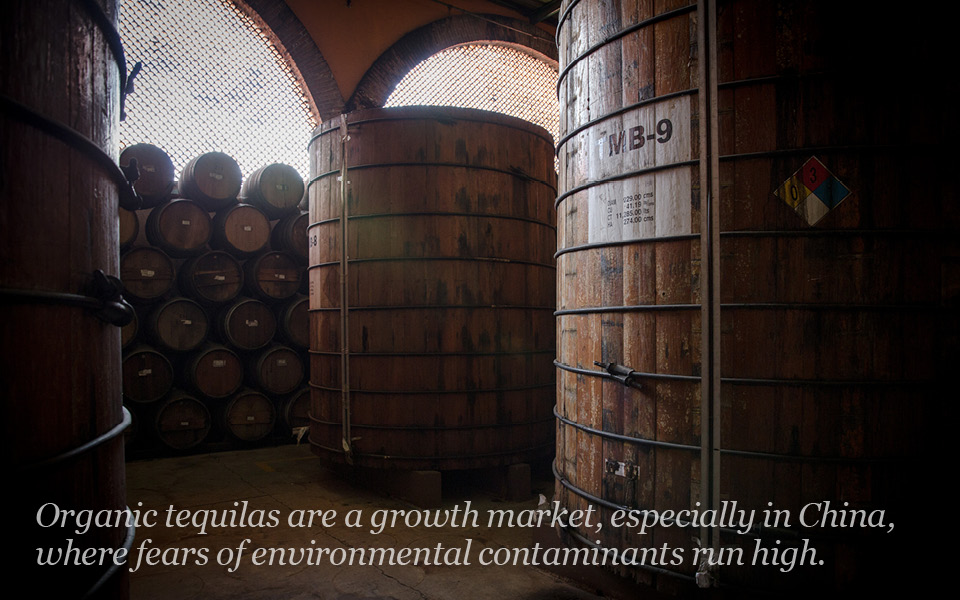
Mary Anne Andrei
And not just for agave. Hurtado initially planted five acres of agave but soon turned the improved soil toward raising organic, non-GMO corn and bought cattle to raise on the feed. Murillo has now trained farmers who grow avocados, limes, strawberries, garlic, and chilies. He offered the instruction for free, and it came with only one condition: Farmers had to agree to share the methods they have learned with others. As the organic gospel spread, it had another, unexpected side benefit. Hurtado and fellow landowners soon expanded operations and began hiring more workers. The village, once devastated by NAFTA and cheap American corn, now offers good-paying farm jobs, reversing the generation-long flow of young people to the United States.
In 2003, 78 percent of households in Agua Negra had at least one member living in the United States—many in California. The reason was simple: You could earn nearly four times as much in the fields of the Central Valley as in those around Agua Negra. But just as the Great Recession was taking hold in the United States, the communities between Agua Negra and Arandas were beginning to thrive. Damien Cave, reporting for the New York Times in 2011, explained simply, “A tequila boom that accelerated through the 1990s created new jobs for farmers cutting agave and for engineers at the stills. Other businesses followed.” With increased commerce came electricity and running water in outlying communities, trash collection and poured-concrete roads in Agua Negra, and the blacktop that now connects the town to Arandas. And over that road, a bus, paid for in part by Murillo, now takes teenagers to the high school in the city, which previously had been too far away to attend. The daughter of Murillo’s farm manager was one of the first to make that trip; she now works in Agua Negra as a teacher.
On a cloudy morning during the festival, Silviano Alvizo Murillo, a distant cousin to Adolfo, took me out to his agave fields, now planted with close to 100,000 plants. Murillo provided Alvizo with manure to till into the soil, showed him how to space his rows of starter plants, and had his ranch manager apply the organic liquid mixture. Between the wide rows on the flatter parts of his land, Alvizo plants beans and corn; on the rockier spots on steeper slopes, he lets native plants grow high. With agave stretching away to the hillsides in every direction, I couldn’t help wondering if he had grander plans. Alvizo smiled and led me up to the house, where he brought out a tiny barrel of tequila—a single batch produced at a local distillery, just enough for parties. But it had gotten Alvizo thinking. Maybe some day he would create his own brand too.
Later, I asked Murillo if he ever worried about fostering his own competition. After all, since he launched Alquimia less than a decade ago, nearly a dozen other certified-organic brands have come on the market and now vie for shelf space in high-end liquor stores and grocery chains like Whole Foods. “Actually,” Murillo said, “it would almost be the opposite. Our hope was that this would catch their attention, to maybe do the same thing for their production.” After all, for all its momentum, organic tequila makes up a tiny fraction of overall sales.
As the sun set on the final day of the festival, Murillo sat in the courtyard of a small home he owns across the street from the church. The bells were tolling as evening Mass let out and fireworks snapped and blossomed overhead. “Our traditional products of Mexico speak so much about our country and our people,” he said, “but the biggest tequila producers are no longer Mexican. And I suppose that’s modern economics, but instead of pulling out all your profits and just exploiting people, why not promote education, promote healthier living?”
As I drove out of the village, back toward Arandas, signs of the progress Murillo envisions were all around. Lining either side of the paved road, rows of agave plants, each like a tiny burst of daggers, turned a deeper blue in the gathering dusk. And, now and then, the red-dirt furrows would be replaced by flowering bushes or grass freshly cut by field-workers, the lights of their houses now blinking to life in the darkness.
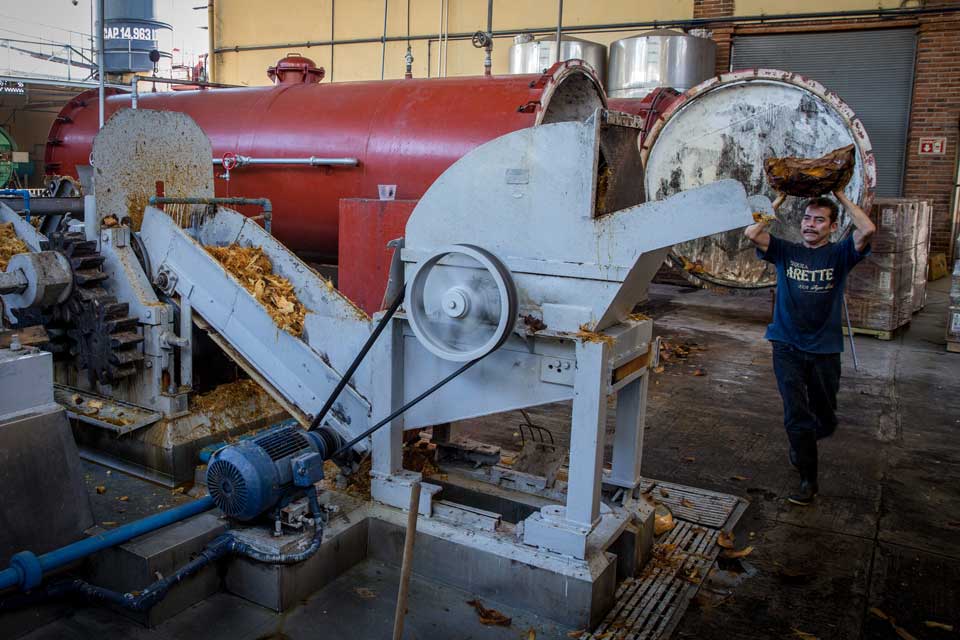
.

